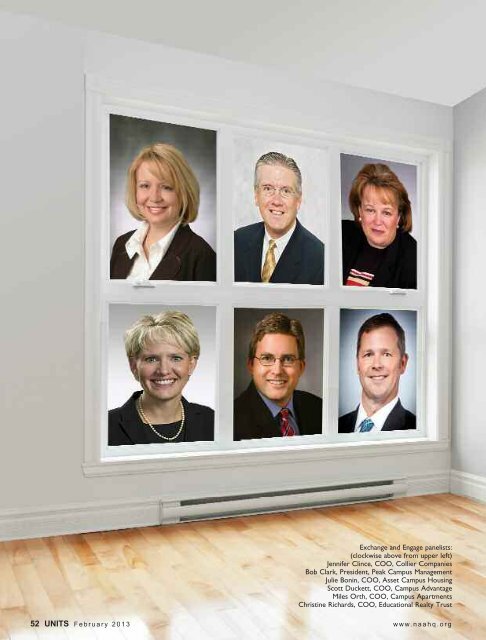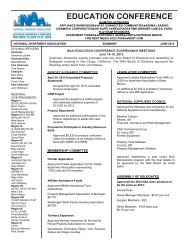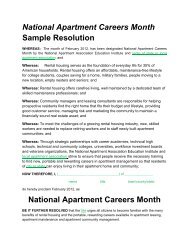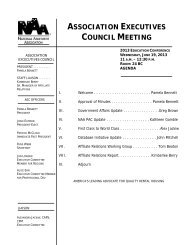full article - National Apartment Association
full article - National Apartment Association
full article - National Apartment Association
You also want an ePaper? Increase the reach of your titles
YUMPU automatically turns print PDFs into web optimized ePapers that Google loves.
Exchange and Engage panelists:<br />
(clockwise above from upper left)<br />
Jennifer Clince, COO, Collier Companies<br />
Bob Clark, President, Peak Campus Management<br />
Julie Bonin, COO, Asset Campus Housing<br />
Scott Duckett, COO, Campus Advantage<br />
Miles Orth, COO, Campus <strong>Apartment</strong>s<br />
Christine Richards, COO, Educational Realty Trust<br />
52 Units F e b r u a r y 2 0 1 3 w w w. n a a h q . o r g
&<br />
Exchange<br />
Top executives will<br />
discuss student housing<br />
trends and challenges.<br />
Engage<br />
BY LAUREN BOSTON<br />
Whether it’s adapting to increasing technology<br />
demands, finding top talent for middlemanagement<br />
positions, or learning from<br />
2012 lease-up challenges, the leading<br />
providers of student housing are constantly<br />
looking to the future.<br />
Four panelists for the 2013 NAA Student Housing Conference<br />
& Exposition’s General Session, “2013 Exchange and Engage<br />
with Executives,” addressed these topics during a recent<br />
interview. Following are highlights:<br />
Q. What are the top three concerns currently<br />
facing the student housing industry?<br />
Orth The same concerns affecting other<br />
businesses are shared by those of us in the<br />
student housing and university real-estate<br />
industry, including consistent flows of capital,<br />
attracting top talent and concerns of<br />
over-supply by inexperienced developers<br />
looking to the short-term only.<br />
Duckett One of our biggest challenges<br />
as an industry is to share information and<br />
create standardized metrics. The large public<br />
REITs have paved the way for standardized<br />
reporting but the industry is still<br />
largely comprised of private companies.<br />
Organizations such as NAA are helping by<br />
providing a venue for the private companies<br />
to safely share information that can<br />
be used to track our industry.<br />
Another is the large number of new<br />
owners and management companies entering<br />
the space with no student housing<br />
About this<br />
General Session<br />
2013 Exchange and Engage<br />
with Executives: The COO Panel<br />
4:15 p.m., Tuesday Feb. 26<br />
Aria, Las Vegas<br />
Moderator<br />
Richard Kelley, Publisher<br />
Student Housing Business<br />
background. Many of the failures in our industry come from<br />
properties that are poorly managed, which leads to negative<br />
publicity. This can affect all of us when colleges, parents, students<br />
and neighborhood groups erroneously hear about mismanaged<br />
properties.<br />
Clark A rush of new capital to the sector could result in overbuilding<br />
in certain markets. The sector still struggles with an<br />
appropriate level of transparency relating to supply and demand<br />
metrics, thus leading to irrational exuberance for new supply.<br />
Related to this concern is the issue of inexperienced entrants into<br />
the student housing industry, which could negatively affect the<br />
sector due to the lack of operating expertise.<br />
Another is that significant increases are being experienced in<br />
the market with regard to real-estate taxes and<br />
property insurance. These trends are largely<br />
uncontrollable, and the effect can be material<br />
on property NOI. We are working with our brokers<br />
and appealing real-estate taxes on behalf<br />
of our clients where it is prudent to do so, and<br />
this will remain a real focus for us as a management<br />
company to continue to be able to<br />
drive property value.<br />
Finally, state and federal fiscal issues may<br />
drive higher tuition, which could result in<br />
lower enrollment. Given the captive audience<br />
in student housing, the industry and/or micro<br />
markets are extremely sensitive to enrollment<br />
swings.<br />
Clince Many challenges we face today we<br />
faced yesterday and will continue to face<br />
tomorrow. We have over-supplied markets.<br />
Excess investment capital is available that is<br />
chasing outsized returns. We are concerned<br />
w w w. n a a h q . o r g F e b r u a r y 2 0 1 3 Units 53
about rising tuition costs competing with discretionary income<br />
available in family budgets for housing. E-learning is a concern<br />
to monitor in the mid- to long-term, although we believe there<br />
are true-life skill development opportunities to young adults<br />
through experiencing independent living in college.<br />
Q. What were the toughest lease-up challenges<br />
of 2012? How will these affect 2013?<br />
Duckett Maintaining high occupancies on the same-store<br />
portfolio in markets with significant increases in supply. Texas<br />
State University, University of South Florida and the University of<br />
Oregon all faced this issue. At the same time, we were focusing<br />
on significantly increasing rental rates, which added another<br />
challenging layer.<br />
For 2013, we have added an extra focus on these markets to<br />
ensure that we are tracking ahead of last year’s pace and we are<br />
keeping an eye on the supply factors.<br />
Clark Overbuilding in certain markets resulted in severe<br />
over-supply and downward pressure on rental rates. In these<br />
cases, we found that our ability to respond in a smart way was<br />
rooted in a keen understanding of the market intelligence that<br />
we gather on a weekly basis. The key was to understand the<br />
trend early, and make the strategy decisions before the bottom<br />
dropped out.<br />
In 2013, we believe that certain markets, such as College Station<br />
and Ole Miss, will continue to experience supply pressure,<br />
and we have planned our strategy in those markets accordingly<br />
to ensure that we get our requisite market share.<br />
Orth Our primary challenges were in three markets: Athens,<br />
Ga.; Riverside, Ca.; and Lafayette, La. We had secondary challenges<br />
in two other markets but were able to overcome them late<br />
in the leasing season. Generally our challenges were related to<br />
over-supply of new product, which will have a temporary impact<br />
on overall market occupancy until the new housing is <strong>full</strong>y<br />
absorbed.<br />
We believe that these markets will rebound in 2013 and early<br />
indications are positive.<br />
Clince Balancing our desired rental rate goals with market<br />
sustainable rates was a challenge in 2012. Our vision of a 2012<br />
economic recovery was lofty. We estimated rental revenue effectively<br />
increasing 5 percent; we pushed the limits in terms of<br />
overall rate growth, but we unintentionally slowed the initial<br />
leasing campaign—requiring additional unplanned gift-card<br />
concessions and rate reductions in July and August, particularly<br />
in Tallahassee and Gainesville, Florida.<br />
In an effort to improve revenue, we have shifted our focus to<br />
total income for 2013. More specifically, we are targeting other<br />
income opportunities, such as utility income. We are using<br />
direct utility billing to generate income. Residents have had preexisting<br />
negative notions on an “inclusive-rent” package that is<br />
Find 2013 NAA Student Housing<br />
Conference & Exposition session<br />
descriptions and copies of PowerPoint<br />
presentations at bit.ly/V7rCi9<br />
not inclusive with associated cap overage expenses. Direct utility<br />
billing sets a clear expectation on day one that each resident will<br />
be billed for what the apartment uses. Our residents’ and parents’<br />
primary concern is having one individual payment due<br />
each month. We accommodate resident and guarantor concerns<br />
by providing the utility services and dividing per-bedroom costs<br />
back to our residents monthly. No negotiating payments between<br />
roommates and no frustration with small utility cap charge<br />
overages each month when the belief was it should have been<br />
included. We have found that in communities that once included<br />
a $40 cap per bed, we have been able to hold rates steady and<br />
eliminate the inclusive utility expense.<br />
Q. What are some of the techniques you use to<br />
fill your middle-management positions?<br />
Orth Finding great people is always a top focus area for our<br />
company. We offer financial rewards for referrals. We find that<br />
excellent people tend to refer other excellent people, and that<br />
helps the company—so we reward that.<br />
Additionally, we have an extraordinary group of students<br />
working with us who look for positions when they graduate—so<br />
we have a constant flow of very bright people looking for unique<br />
opportunities. Because we are in the university real-estate business,<br />
we tend to interact with very bright people and are able to<br />
attract them into our company with our culture and values.<br />
In short, we attract top talent through referrals, communicating<br />
our culture and looking to university campuses for excellent<br />
talent.<br />
Duckett We focus heavily on internal promotions. We have<br />
had much greater success promoting team members who understand<br />
our systems and culture. That said, we also view recruiting<br />
as a team sport. Our internal staff members work with our<br />
recruiting team to identify top outside talent and begin developing<br />
relationships for future openings.<br />
Clark Our middle-management really translates to our property<br />
manager position, which we view as the single most important<br />
hire we make at each asset. People matter most—thus<br />
attracting, training and retaining our people is a daily strategic<br />
initiative. Student housing is a very tightly connected industry,<br />
and we find that our ability to attract top talent is driven by how<br />
the market perceives our company.<br />
One of the best recruiting tools we have is our culture, whereby<br />
existing employees recruit their network of student housing<br />
professionals because they love working at this company. Further,<br />
we find that if we take care of our people, support them,<br />
remain transparent as an organization and celebrate our successes,<br />
then the top talent will seek us out.<br />
We’ve also spent a great deal of time and resources building<br />
and maintaining an active database of student housing professionals<br />
who we would like to see join our team. We establish and<br />
continue an open line of communication with these individuals<br />
long before we have a position available. A people-first culture<br />
and proactive recruiting are key strategies for us.<br />
Clince We are all competing in the same game and the team<br />
representing you on the field is critical to your play execution.<br />
54 Units F e b r u a r y 2 0 1 3 w w w. n a a h q . o r g
We believe in building our bench through both development<br />
and talent recruitment. To build and enhance our team we have<br />
added a <strong>full</strong>-time training manager and we have created an inhouse<br />
talent acquisition manager (TAM) to identify internal—<br />
and solicit external—talent. Our TAM has a pulse on our team<br />
members’ skill sets and open positions, and clearly communicates<br />
job-performance expectations and required skills.<br />
We have found that transparency from start to finish with<br />
needs, expectations, process updates and awards builds trust and<br />
understanding on how one can advance within our company.<br />
Our Training Manager works in tandem with our TAM to ensure<br />
we are building career-path plans for our team members actively<br />
seeking to grow with us. Team members will be actively<br />
solicited to participate in training and mentoring opportunities,<br />
giving them exposure to necessary skills in line with their<br />
career-path plan. We actively seek candidates with a strong drive<br />
and passion for excellence and a strong work ethic.<br />
For external advertising we have found traditional advertising<br />
placements have not yielded the same success as less expensive,<br />
pay-per-click advertising on websites such as indeed.com.<br />
Q. Students now expect Wi-Fi and Internet connectivity<br />
in the same way they expect electricity<br />
and water. Where can student housing operators<br />
go from here to take their telecommunications<br />
and broadband offerings to the next level?<br />
Orth This is an area that our team is constantly evaluating.<br />
We have team members in our technology group who are<br />
thought leaders in this area and who are regularly evaluating<br />
the connectivity in our buildings compared to our predictions of<br />
the technology and the state of the art, our competitors and the<br />
university communities we serve.<br />
Three years ago, offering 200 megabytes of bandwidth to a<br />
property was cutting edge. We’re now anticipating 1 gigabyte of<br />
connectivity to single student-housing properties to meet or<br />
exceed market expectations and address student demand for fast,<br />
reliable Internet connectivity.<br />
This has been driven by a number of factors, not least that<br />
student housing residents now regularly use multiple Internetconnected<br />
devices and consume most of their media content via<br />
the Internet. In reality, most of our residents are streaming TV<br />
and movie content via the Internet instead of using TVs with a<br />
cable connection.<br />
As to what student housing operators can do, they need to<br />
take control of their Internet delivery by working with companies<br />
that do not require long-term contracts and who understand<br />
the student housing model.<br />
Our technology team prepares a white paper on this topic<br />
each year which measures the usage of bandwidth both globally<br />
and in the United States compared to previous years and<br />
provides projections into the future for both bandwidth and<br />
student housing network design. Their estimates have largely<br />
w w w. n a a h q . o r g<br />
F e b r u a r y 2 0 1 3 Units 55
een spot-on, which reflects an enormous<br />
increase in bandwidth for users in<br />
this country.<br />
It is notable that Internet bandwidth<br />
in the United States is actually much<br />
less than it is for our competitive peers<br />
in other nations. As time rolls on, this<br />
differential will likely smooth out with<br />
the United States experiencing significant<br />
increases in usages. We make this<br />
paper available to anyone who requests<br />
it.<br />
Duckett It’s important that any new<br />
56 Units F e b r u a r y 2 0 1 3<br />
projects have wired connections as well as<br />
a wireless overlay. Students now demand<br />
both.<br />
Additionally, systems that were set up<br />
just two or three years ago may need to<br />
be enhanced because of increased bandwidth<br />
demands.<br />
We work with a number of national<br />
providers to monitor and ensure that our<br />
Internet delivery meets the needs of students.<br />
Clark I would argue that Internet has<br />
actually become more important than<br />
water and electricity at most student<br />
housing properties. We joke internally<br />
that we could shut off water to our property<br />
for four hours and not hear a peep<br />
from our residents, but if Internet were to<br />
go out for 15 minutes, our phones would<br />
be ringing off the hook.<br />
This is the reality for this sector of<br />
real estate, and we find that our ability<br />
to succeed in our markets is largely<br />
driven by our reputation for providing<br />
a lightning fast, reliable Internet connection.<br />
Our strategy continues to be constantly<br />
thinking forward when it comes to Internet<br />
service, bandwidth and technology.<br />
We are strategic in our contract negotiations<br />
to make sure that we have terms<br />
that are favorable and flexible for upward<br />
expansion of bandwidth. From a design<br />
standpoint, our IT department consults<br />
with our clients to ensure that the infrastructure<br />
at properties is not only state-ofthe-art<br />
from today’s standards, but also<br />
has the ability to evolve to the standards<br />
of what we see happening 10 years from<br />
now.<br />
As we continue to see students consuming<br />
more content and communicating<br />
online versus other avenues, we’re<br />
focused on providing market-leading<br />
bandwidth, and actively servicing that<br />
connection so that it remains stable and<br />
reliable for our residents.<br />
Clince Reliability, reliability, reliability.<br />
If our Internet purveyor is not reliable,<br />
it does not matter how much<br />
bandwidth we provide. Services must be<br />
available on demand. As Internet<br />
providers improve services, demand for<br />
bandwidth increases; it’s a never-ending<br />
arms race.<br />
We look for shorter-term agreements<br />
with room for bandwidth growth. We<br />
require service guarantees at the user<br />
level rather than site level. It is not an<br />
area to cut corners. As costs decrease for<br />
current service levels and demands<br />
increase for additional service levels, this<br />
is an area of long-term continuous<br />
investment.<br />
Lauren Boston is NAA’s Staff Writer. She<br />
can be reached at lauren@naahq.org<br />
or 703/797-0678.<br />
w w w. n a a h q . o r g








